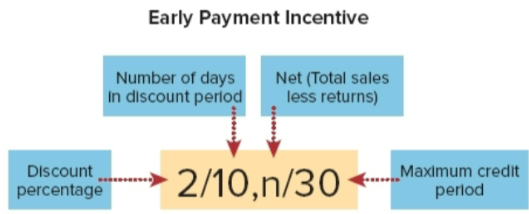Chapter 6: Reporting & Interpreting Sales Revenue, Receivables, and Cash
Chapter 6:
Revenues Recognition Principle:
When a company transfers promised goods/services to a customer
In the amount expected to receive
Transferred: When titles & risks of ownership transfer to the buyer
Options:
When the goods are shipped → FOB Shipping Point
When the goods reach their destination → FOB Destination
Revenue on Income Statement:
Gross Revenues → Revenue Acct (R)
Contra-Rev Acct (XR)
Credit Card “Discounts”
Sales Discounts
Returns & Allowances
Net Sales Revenue → Where the income statement starts
Credit Card Sales (Customers):
Companies often accept Credit card payments from customers
Credit card companies charge a fee for this service (credit card discount)
Since the company will never collect this cash, revenue should be reduced
Some Companies report credit card discounts in other operating expense line items, ie Selling, General, & Administrative Expenses
Sales Discounts to Businesses:
Companies often provide direct credit to business customers
Credit sales occur on an “open account” with no formal written promissory note
Credit sale terms are printed on a sales document & invoice

Sales Discounts encourage prompt payment from customers, reducing the need for the company to borrow money to meet operating needs
Customers often pay bills by providing discounts first
Sales Returns & Allowances:
Customers have a right to return unsatisfactory or damaged merchandise and receive a refund or adjustment to their bill (allowance)
Sales (& associated receivables) must be reduced when returns occur or when allowances are offered
Revenue for Bundled Goods & Services:
Bundling of goods & services within one sales contract is common in a variety of industries
When a seller promises multiple goods or services in a single sales contract, they must:
Determining the value of each good & service
Recognize revenue when the performance obligation is satisfied
Receivables:
When companies generate credit sales, companies record receivables
Because receivables represent a right to collect cash in the future
A certain portion may become uncollectible
GAAP requires companies to record Bad Debt Expense (E) to reflect the estimated uncollectible amount
Since collectability is often uncertain, companies use an allowance account, Allowance for Doubtful Accounts (XA), to record aggregated bad debt expense
Writing off Specific Accounts:
Occasionally, it becomes known that a specific account is uncollectible (ie bankruptcy)
Receivable needs to be removed (credited) since it is no longer expected to provide a future economic benefit
Allowance also needs to be reduced (debited) since a reserved portion of the estimated uncollectible amount has been realized
Calculating Bad Debt/Allowance:
Two main methods to estimate Bad Debt in the period of the sale
Percentage of Credit Sales:
Focus on changes
Calculate Bad Debt Expense as a present of total credit sales for the period
Use historical % of credit sales resulting in bad debts
Bad Debt Expense = Total Credit Sales x Bad Debt 5
Debit calculated Bad Debt Expense
As a debit & credit Allowance for Doubtful Accounts for the same amount
Aging of The Accounts Receivable:
Focus on the Balance
Calculate the uncollectible portion of A/R (allowance) based on the age of existing receivables
As receivable gets older & more overdue, it is less likely to be collected
Record Bad Debt Expenses to update the Allowance balance to the desired amount